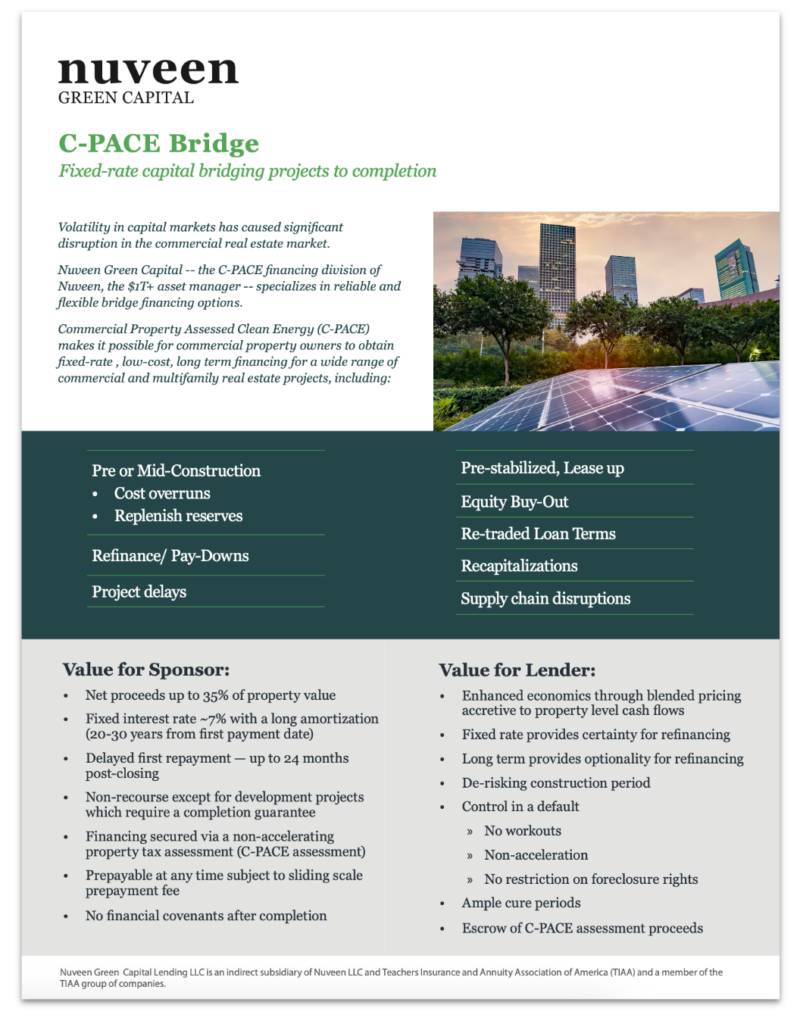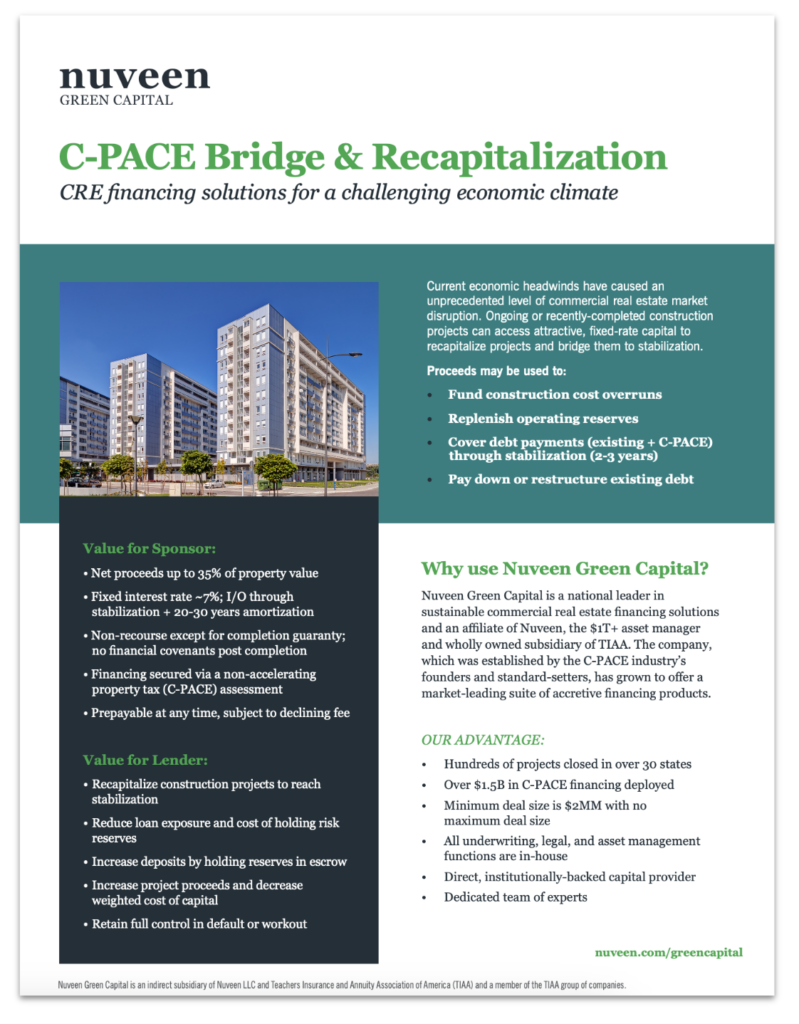Nuveen Green Capital leverages C-PACE to help borrowers assemble their capital stack
Nuveen Green Capital is helping borrowers fill the financing void for commercial real estate projects with its C-PACE lending platform.
“Given this financing climate where banks have really pulled back, we’ve seen an incredible surge in demand for C-PACE,” says Kate Cusack, head of originations at Nuveen Green Capital, a national leader in sustainable commercial real estate financing solutions and an affiliate of Nuveen, a $1+ trillion asset manager and wholly owned subsidiary of TIAA. When The Real Deal last sat down with Nuveen Green Capital, the firm was predicting explosive growth for its C-PACE lending platform. Higher interest rates and tighter lending have pushed those expectations even higher. The firm is on pace to double its originations volume this year.
C-PACE is increasingly being used on larger-scale projects and is garnering interest from borrowers across the spectrum, including large institutions. Over the past year, Nuveen Green Capital has seen its average loan size jump nearly threefold. Traditionally, borrowers have used C-PACE financing to boost leverage from perhaps 70 to 75%. Now a lot of borrowers are using the fixed-rate, non-recourse financing mechanism for up to 40% of their development costs. “We are seeing a lot of borrowers who are really using C-PACE as the cornerstone of their capital stack,” says Cusack. The firm works on C-PACE deals that are typically $2 million or larger.
Commercial Property Assessed Clean Energy (C-PACE) is a financing mechanism that provides commercial property owners access to low-cost, long-term, fixed-rate capital for energy efficiency, water conservation, and renewable energy improvements that are paid back over a 20+ year term through a special property assessment. One of the unique aspects of C-PACE is that it is non-recourse financing that is structured as an assessment, much like a street assessment, versus a typical mortgage.
Bridge & refi solution
C-PACE can be used in a variety of different situations – renovation of an existing building, new ground-up development and refinancing of projects completed within the last two to three years. “The beauty of C-PACE is that it’s very malleable, depending on the situation and the economic environment. It can be used as a bridge product; it can be used for construction financing; and it also can be used as a recapitalization strategy. C-PACE is so in demand these days because it can fit into many different strategies for a borrower,” says Cusack.
Increasingly, borrowers are leveraging C-PACE as a bridge financing product. It is an attractive alternative or replacement to higher-cost floating-rate debt, especially for borrowers who have no interest rate caps or caps that are expiring. C-PACE can also be used to bridge cash flow shortages, something that was particularly relevant during the Covid-19 pandemic. “Given the stress in the office environment, similar to the stress in the hotel market during the pandemic, our expectation is that we’re going to see more demand in that area,” says Cusack.
For example, Nuveen Green Capital provided $15.2M in C-PACE bridge financing for a warehouse project located in Baltimore, MD. C-PACE financing recapitalized recently completed improvements that benefited both the energy efficiency and resiliency of the property. The retroactive funding was able to offset higher than anticipated tenant improvement costs, and the overall additional investment allowed for the building to maintain adequate interest reserves for their acquisition and construction loan, as well as to make the improvements necessary to lease up the long-vacant space.
C-PACE also can be used to refinance energy-efficient upgrades in buildings completed within the last two to three years, depending on the individual C-PACE program. Borrowers can retroactively finance those energy improvements, and use those dollars for a number of things, such as paying down senior debt, replenishing operating reserves, and allowing the sponsor to monetize their equity.
C-PACE in action
Nuveen Green Capital recently provided just over $30 million in C-PACE funding to refinance extensive energy efficiency measures that had been completed at the Arlo Wynwood Hotel, a new 217-room luxury boutique hotel located in Miami’s vibrant Wynwood neighborhood. “C-PACE financing offered significantly lower leverage and lower cost than the traditional commercial real estate financing options,” says Jared White, head of acquisitions at Quadrum Global, the project developer.
Because the hotel is brand new with no historical performance, traditional lenders would have made the financing far more challenging. However, because C-PACE proceeds are linked to energy efficiency measures, the lack of historical performance wasn’t a barrier to financing.
C-PACE’s fixed-rate and long-term aspects were especially attractive with the volatile market. “In an uncertain interest rate environment, the permanence and assumable nature of C-PACE provided the perfect counterweight to the macroeconomic climate, and we believe it could make a major difference in the asset value if we were to ever sell,” adds White. “Lastly, it has minimal covenants and restrictions such as reporting, guarantees, etcetera. These don’t sound like much, but they are operationally and organizationally burdensome, so to have a loan with so few ‘strings attached’ is quite refreshing.”
Strong value proposition
Growing awareness of the value proposition of C-PACE is helping to move the structure more into mainstream financing. In the current environment, C-PACE offers a relatively low rate in comparison to other financing options. “For the first time, we’re pricing inside of a lot of construction debt, and for that reason, borrowers are really coming to us to max out the C-PACE as a component of their debt stack,” says Cusack. Some of the other key attributes that borrowers like include:
- Net proceeds up to 35% of property value
- Fixed interest rate ~7% with a long amortization (20-30 years from the first payment date)
- Non-recourse, except for development projects, which require a completion guaranty
- Financing secured via a non-accelerating property tax assessment (C-PACE assessment)
- Prepayable at any time, subject to sliding scale prepayment fee
- No financial covenants after completion
Another value for borrowers is that C-PACE typically has a built-in capitalized interest period. No payments are due for up to 24 months after closing, regardless of whether the situation is for new construction or refinancing. That feature gives the borrower time to stabilize or complete their project, or perhaps replenish some operating reserves before a payment is actually due.
C-PACE also works well with a variety of different debt instruments. Previously, it was challenging to get senior lenders to consent to C-PACE, but those views are changing. “Senior lenders have begun to really open their eyes to C-PACE because we are able to provide needed capital and also blend down the weighted cost of capital,” says Cusack. “So, there are various value propositions for a senior lender in this particular market that we are now able to tap into to help get deals done.”
This article was produced by The Real Deal’s Brand Studio Team in conjunction with Nuveen Green Capital. For more information about working with our Brand Studio Team please click here.





